Predicting Fine Dead Fuel Load of Forest Floors Based on Image Euler Numbers
Abstract
:1. Introduction
2. Material and Methods
2.1. Study Area
2.2. Standardization and Sample Collection
2.3. Laboratory Experiment
2.3.1. Construction of Fuel Beds with Different Loads
2.3.2. Image Capture
2.3.3. Image Processing and Feature Extraction
2.4. Data Processing
2.4.1. Statistical Analysis
2.4.2. Correlation Analysis
2.4.3. A Prediction Model for Fine Fuel Bed Loads Based on Euler Numbers
Establishment of the Model
- Stepwise regression (FL1). Using the load of the fine dead fuel bed on the surface as the dependent variable and the Euler number (at all thresholds) as the independent variable, a forward stepwise regression method was conducted to establish a load prediction model.
- Nonlinear fitting (FL2). The Euler number obtained at the image conversion threshold producing the maximum correlation coefficient was selected as the dependent variable. Owing to the large absolute values of the Euler numbers, the model parameters were too large and complex for nonlinear fitting. Therefore, the logarithm of the absolute value of the Euler number was used. A scatter plot was drawn with the load of surface fine dead fuel along the vertical axis and the logarithm of the Euler number along the horizontal axis. The variation in bed load according to the Euler number was analyzed, selecting an appropriate model form (with R2 maximum as the selection criterion), and least squares fitting parameters were selected to obtain a nonlinear fitting model based on the Euler number.
- Random forest algorithm (FL3). The random forest machine learning algorithm was used to establish a prediction model. Two important parameters are required for this technique: the number of decision trees (ntree) and the number of random features (mtry) [31]. MATLAB R2023b was used to establish the relationship between the number of decision trees and errors, determine the range of decision trees, determine the most suitable decision tree value by measuring the prediction performance of different decision tree numbers, and ultimately obtain the final random forest prediction model.
Verification of Prediction Model for the Surface Dead Fuel Load
3. Results
3.1. Basic Statistics
3.2. Correlation Analysis
3.3. Prediction Models
3.3.1. Model Results
- Stepwise regression (FL1). For the P. massoniana needle fuelbed, Euler numbers were entered into the regression equation for image thresholds of 0.05, 0.10, 0.70, 0.90, and 0.95. The corrected R2 value was 0.637, and the MAE and MRE were 2.39 t/ha and 28.85%, respectively. For the broad-leaved bed of Q. fabri, Euler numbers were entered into the equation for image thresholds of 0.25, 0.5, 0.75, 0.8, 0.85, and 0.9. Here, the corrected R2 value was 0.654, and the MAE and MRE were 2.22 t/ha and 26.89%, respectively (Table 2).
- 2.
- Nonlinear fitting method (FL2). According to the correlation analysis results, the Euler number with the highest correlation coefficient was associated with image thresholds of 0.7 and 0.05 for P. massoniana and Q. fabri fuelbeds, respectively, for use as predictive factors in the nonlinear fitting model. When the load was 11 t/ha, it exhibited different trends with respect to the logarithm of the Euler number for the two fuel types. For P. massoniana fine dead fuels, as the load increased, the load first exhibited a quadratic function in relation to the logarithm of the Euler number, but thereafter showed a linear downward trend. In contrast, for Q. fabri fine dead fuels, the load first followed a cubic function trend in relation to the logarithm of the Euler number, but at loads ≥11 t/ha, an increasing quadratic function trend was observed (Figure 6).
- 3.
- Random forest method (FL3). Figure 7 shows the number of decision trees and the error distribution of our random forest model. Errors tended to stabilize when the number of decision trees reached 400. According to the left panel in Figure 7, both P. massoniana and Q. fabri exhibited the best predictive performance at a decision tree value of 1000 and with the minimum number of leaves set at 1.
3.3.2. Model Comparisons
4. Discussion
5. Conclusions
Author Contributions
Funding
Data Availability Statement
Acknowledgments
Conflicts of Interest
References
- Alonso-Rego, C.; Arellano-Pérez, S.; Cabo, C.; Ordoñez, C.; Álvarez-González, J.G.; Díaz-Varela, R.A.; Ruiz-González, A.D. Estimating Fuel Loads and Structural Characteristics of Shrub Communities by Using Terrestrial Laser Scanning. Remote. Sens. 2020, 12, 3704. [Google Scholar] [CrossRef]
- Batcheler, M.; Smith, M.M.; Swanson, M.E.; Ostrom, M.; Carpenter-Boggs, L. Assessing silvopasture management as a strategy to reduce fuel loads and mitigate wildfire risk. Sci. Rep. 2024, 14, 5954. [Google Scholar] [CrossRef] [PubMed]
- Bonham, C.D. Measurements for Terrestrial Vegetation; John Wiley & Sons: New York, NY, USA, 1989; 338p. [Google Scholar]
- Catchpole, W.R.; Wheeler, C.J. Estimating plant biomass: A review of techniques. Aust. J. Ecol. 1992, 17, 121–131. [Google Scholar] [CrossRef]
- Chavez-Duran, A.A.; García, M.; Olvera-Vargas, M.; Aguado, I.; Figueroa-Rangel, B.L.; Trucíos-Caciano, R.; Rubio-Camacho, E.A. Forest Canopy Fuel Loads Mapping Using Unmanned Aerial Vehicle High-Resolution Red, Green, Blue and Multispectral Imagery. Forests 2024, 15, 225. [Google Scholar] [CrossRef]
- Clarke, H.; Pitman, A.J.; Kala, J.; Carouge, C.; Haverd, V.; Evans, J.P. An investigation of future fuel load and fire weather in Australia. Clim. Chang. 2016, 139, 591–605. [Google Scholar] [CrossRef]
- Deeming, J.E.; Burgan, R.E.; Cohen, J.D. The National Fire-Danger Rating System—1978; Gen. Tech. Rep. INT-GTR-39; U.S. Department of Agriculture, Forest Service, Intermountain Forest and Range Experiment Station: Ogden, UT, USA, 1977; 63p.
- de Groot, W.J.; Landry, R.; Kurz, W.A.; Anderson, K.R.; Englefield, P.; Fraser, R.H.; Hall, R.J.; Banfield, E.; Raymond, D.A.; Decker, V.; et al. Estimating direct carbon emissions from Canadian wildland fires. Int. J. Wildland Fire 2007, 16, 593–606. [Google Scholar] [CrossRef]
- Finney, M.A. FARSITE: Fire Area Simulator-Model Development and Evaluation; Res. Pap. RMRS-RP-4; U.S. Department of Agriculture, Forest Service, Rocky Mountain Research Station: Ogden, UT, USA, 2004; 47p.
- Fujimoto, A.; Haga, C.; Matsui, T.; Machimura, T.; Hayashi, K.; Sugita, S.; Takagi, H. An End to End Process Development for UAV-SfM Based Forest Monitoring: Individual Tree Detection, Species Classification and Carbon Dynamics Simulation. Forests 2019, 10, 680. [Google Scholar] [CrossRef]
- Gosper, C.R.; Yates, C.J.; Prober, S.M.; Wiehl, G. Application and validation of visual fuel hazard assessments in dry Mediterranean-climate woodlands. Int. J. Wildland Fire 2014, 23, 385–393. [Google Scholar] [CrossRef]
- Gould, J.S.; McCaw, W.L.; Cheney, N.P. Quantifying fine fuel dynamics and structure in dry eucalypt forest (Eucalyptus marginata) in Western Australia for fire management. For. Ecol. Manag. 2011, 262, 531–546. [Google Scholar] [CrossRef]
- He, R.; Lu, H.; Jin, Z.Z.; Qin, Y.; Yang, H.; Liu, Z.; Yang, G.; Xu, J.; Gong, X.; Zhao, Q. Construction of forest fire prediction model and driving factors analysis based on random forests algorithm in Southwest China. Acta Ecol. Sin. 2023, 43, 9356–9370. [Google Scholar] [CrossRef]
- Jin, S.; Chen, P. Modelling drying processes of fuelbeds of Scots pine needles with initial moisture content above the fibre saturation point by two-phase models. Int. J. Wildland Fire 2012, 21, 418–427. [Google Scholar] [CrossRef]
- Kang, S.Y.; Yao, B. Target counting method of grain particle images based on Euler numbers. Hubei Agric. Sci. 2023, 62, 197–201. [Google Scholar] [CrossRef]
- Keane, R.E. Describing wildland surface fuel loading for fire management: A review of approaches, methods and systems. Int. J. Wildland Fire 2013, 22, 51–62. [Google Scholar] [CrossRef]
- Keane, R.E.; Burgan, R.; van Wagtendonk, J. Mapping wildland fuels for fire management across multiple scales: Integrating remote sensing, GIS, and biophysical modeling. Int. J. Wildland Fire 2001, 10, 301–309. [Google Scholar] [CrossRef]
- Kucuk, O.; Saglam, B.; Bilgili, E. Canopy Fuel Characteristics and Fuel Load in Young Black Pine Trees. Biotechnol. Biotechnol. Equip. 2007, 21, 235–240. [Google Scholar] [CrossRef]
- Liang, Y.; Li, J.M.; Zhao, F.J.; Zhang, Y.; Kong, T.; Nurgul, M. Surface fuel loads of Tianshan spruce forests in the central Tianshan Mountains and the impact factors. Sci. Silvae Sin. 2017, 53, 153–160. [Google Scholar] [CrossRef]
- Liu, X.; Huang, Y.; Ding, B.; Wu, Y.; Zhang, Y.W.; Li, J.F.; Zhang, Y.L. Influencing factors of surface fine dead fuel loading in typical forest stands of Dalou Mountain. J. Cent. South Univ. For. Technol. 2023, 43, 9–16. [Google Scholar] [CrossRef]
- Lydersen, J.M.; Collins, B.M.; Knapp, E.E.; Roller, G.B.; Stephens, S. Relating fuel loads to overstorey structure and composition in a fire-excluded Sierra Nevada mixed conifer forest. Int. J. Wildland Fire 2015, 24, 484–494. [Google Scholar] [CrossRef]
- Mallinis, G.; Mitsopoulos, I.D.; Dimitrakopoulos, A.P.; Gitas, I.Z.; Karteris, M. Local-Scale Fuel-Type Mapping and Fire Behavior Prediction by Employing High-Resolution Satellite Imagery. IEEE J. Sel. Top. Appl. Earth Obs. Remote. Sens. 2008, 1, 230–239. [Google Scholar] [CrossRef]
- Mueller-Dombois, D.; Ellenberg, H. Aims and Methods of Vegetation Ecology; John Wiley & Sons: New York, NY, USA, 1974. [Google Scholar]
- Neary, D.G.; Klopatek, C.C.; DeBano, L.F.; Ffolliott, P.F. Fire effects on belowground sustainability: A review and synthesis. For. Ecol. Manag. 1999, 122, 51–71. [Google Scholar] [CrossRef]
- Ottmar, R.D.; Hardy, C.C. Stereo Photo Series for Quantifying Forest Residues in Coastal Oregon Forests: Second-Growth Douglas-Fir—Western Hemlock Type, Western Hemlock—Sitka Spruce Type, and Red Alder Type; Gen. Tech. Rep. PNW-GTR-231; U.S. Department of Agriculture, Forest Service, Pacific Northwest Research Station: Portland, OR, USA, 1989.
- Qiu, C.; Han, X.Z.; Chen, X.; Lu, X.; Yan, J.; Feng, Y.; Gan, J.; Zou, W.; Liu, G. Effects of organic amendment depths on black soil pore structure using CT scanning technology. Trans. Chin. Soc. Agric. Eng. 2021, 37, 98–107. [Google Scholar] [CrossRef]
- Rothermel, R.C. A Mathematical Model for Predicting Fire Spread in Wildland Fuels; Res. Pap. INT-115; U.S. Department of Agriculture, Forest Service, Intermountain Forest and Range Experiment Station: Ogden, UT, USA, 1972.
- Schaaf, M.D.; Sandberg, D.V.; Schreuder, M.D.; Riccardi, C.L. A conceptual framework for ranking crown fire potential in wildland fuelbeds. Can. J. For. Res. 2007, 37, 2464–2478. [Google Scholar] [CrossRef]
- Shan, H.; Zhang, S.Q.; Zhao, Y.; Cao, Y.G.; Xu, S.Z.; Liu, X. Study on the relationship of clay Euler number with physical and mechanical indexes based on independent component analysis. J. China Three Gorges Univ. Nat. Sci. 2023, 45, 50–55. [Google Scholar] [CrossRef]
- Sheng, M.Y.; Xiong, K.N.; Cui, G.Y.; Liu, Y. Plant diversity and soil physical-chemical properties in karst rocky desertification ecosystem of Guizhou, China. Acta Ecol. Sin. 2015, 35, 434–448. [Google Scholar]
- Sun, P.; Zhang, Y.; Sun, L.; Hu, H.; Guo, F.; Wang, G.; Zhang, H. Influence of Fuel Moisture Content, Packing Ratio and Wind Velocity on the Ignition Probability of Fuel Beds Composed of Mongolian Oak Leaves via Cigarette Butts. Forests 2018, 9, 507. [Google Scholar] [CrossRef]
- Wang, Y.W.; Suo, A.L.; Gao, Y.; Wang, B.; Chen, F.; Liu, X. Surface fuel load and influencing factors of Pinus yunnanensis forest in Xichang City, Sichuan Province of Southwestern China. J. Beijing For. Univ. 2023, 45, 100–108. [Google Scholar]
- Watson, P.J.; Penman, S.H.; Bradstock, R.A. A comparison of bushfire fuel hazard assessors and assessment methods in dry sclerophyll forest near Sydney, Australia. Int. J. Wildland Fire 2012, 21, 755–763. [Google Scholar] [CrossRef]
- Yao, B.; He, H.; Kang, S.; Chao, Y.; He, L. A Review for the Euler Number Computing Problem. Electronics 2023, 12, 4406. [Google Scholar] [CrossRef]
- Yao, B.; He, L.; Kang, S.; Zhao, X.; Chao, Y. A new run-based algorithm for Euler number computing. Pattern Anal. Appl. 2017, 20, 49–58. [Google Scholar] [CrossRef]
- Zhang, C.; Tian, H.; Wang, Y.; Zeng, T.; Liu, Y. Predicting response of fuel load to future changes in climate and atmospheric composition in the Southern United States. For. Ecol. Manag. 2010, 260, 556–564. [Google Scholar] [CrossRef]
- Zhang, Y.L. Modeling the drying process of Masson pine needle fuel beds under different packing ratios based on two-phase models in the laboratory. PeerJ 2022, 10, e14484. [Google Scholar] [CrossRef] [PubMed]
- Zhang, Z.; Zong, S.Q.; Yan, X.Q.; Zhang, H.; Huang, H.; Zhai, Y.; Fu, L. Effects of stand and terrain factors on forest surface fuel load in the core area of Chongli Winter Olympic Games. Sci. Silvae Sin. 2022, 58, 59–66. [Google Scholar] [CrossRef]
- Zhou, J.Q.; Liu, X.D.; Zhang, S.Y. Study on the distribution of surface combustibles in Larix gmelinii plantation. For. Fire Prev. 2019, 2019, 19–23. [Google Scholar]
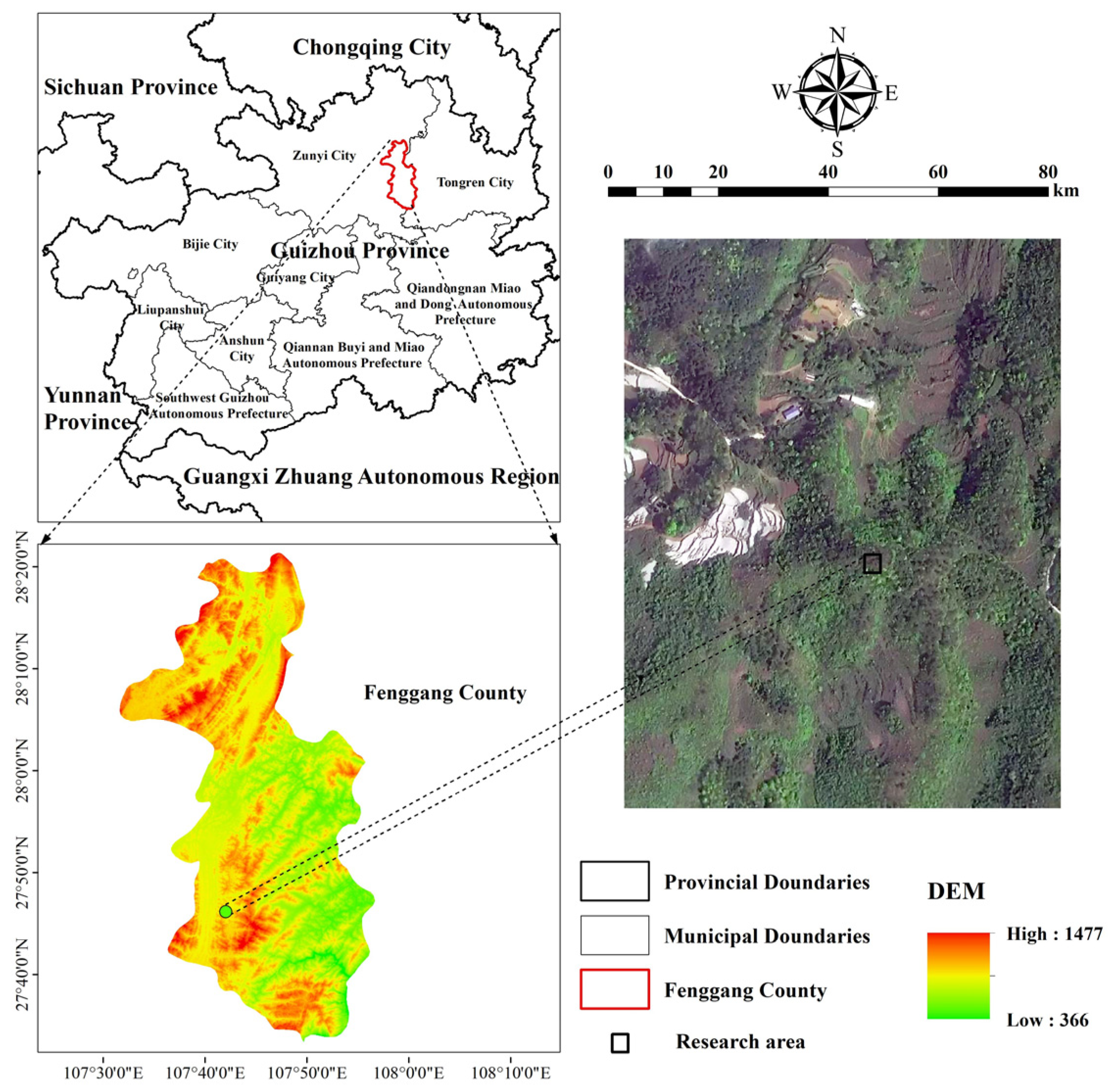
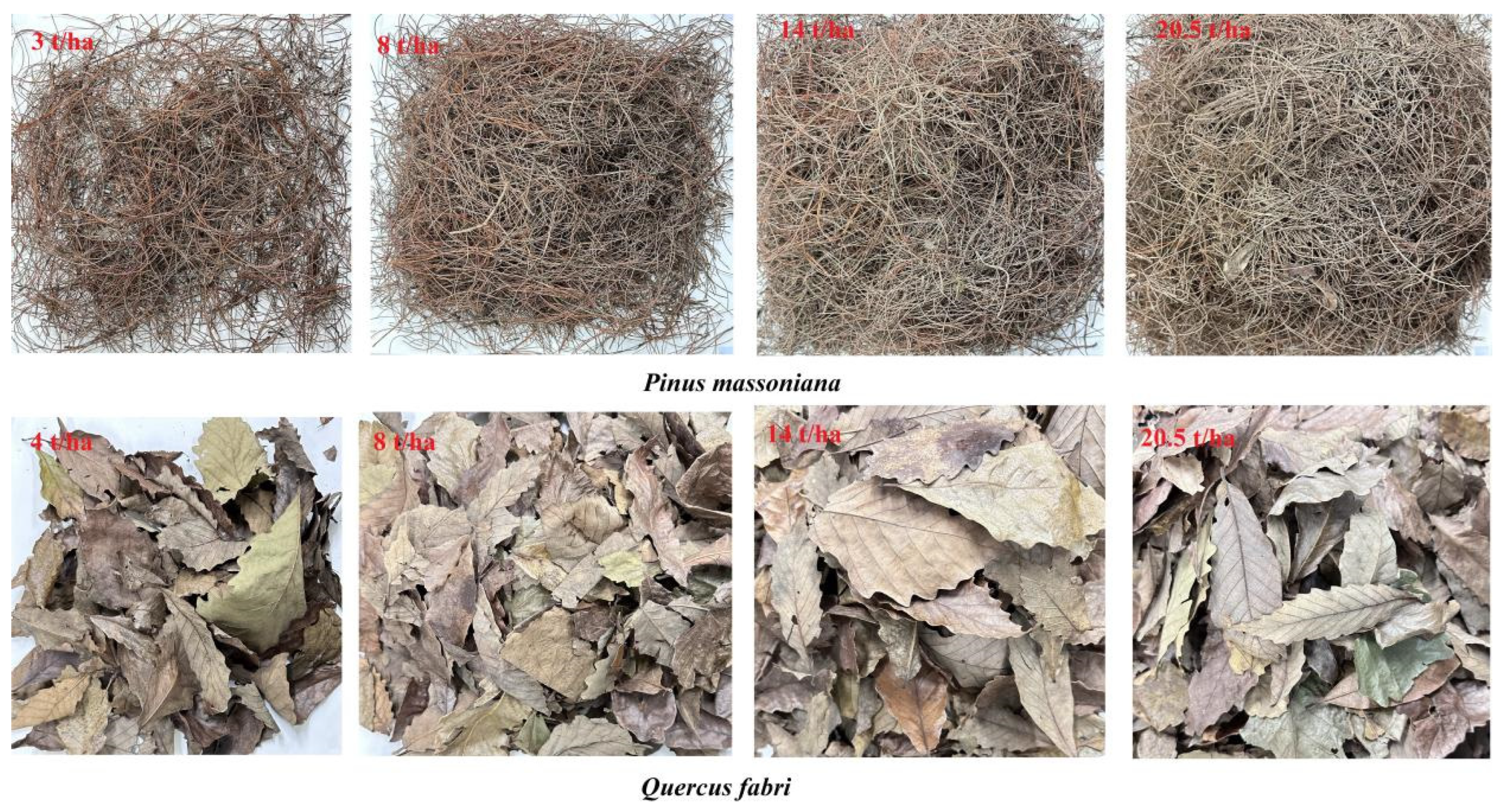


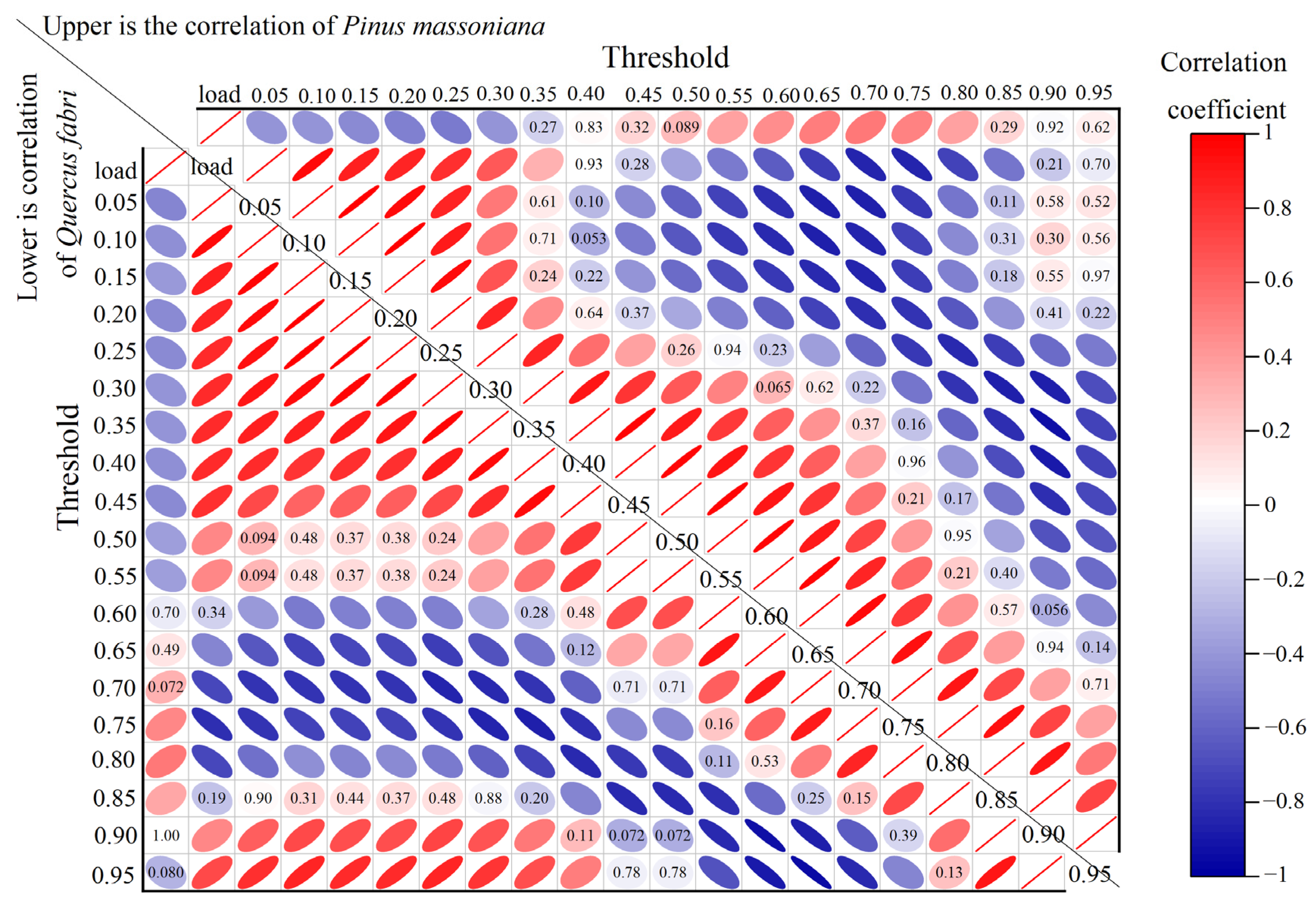
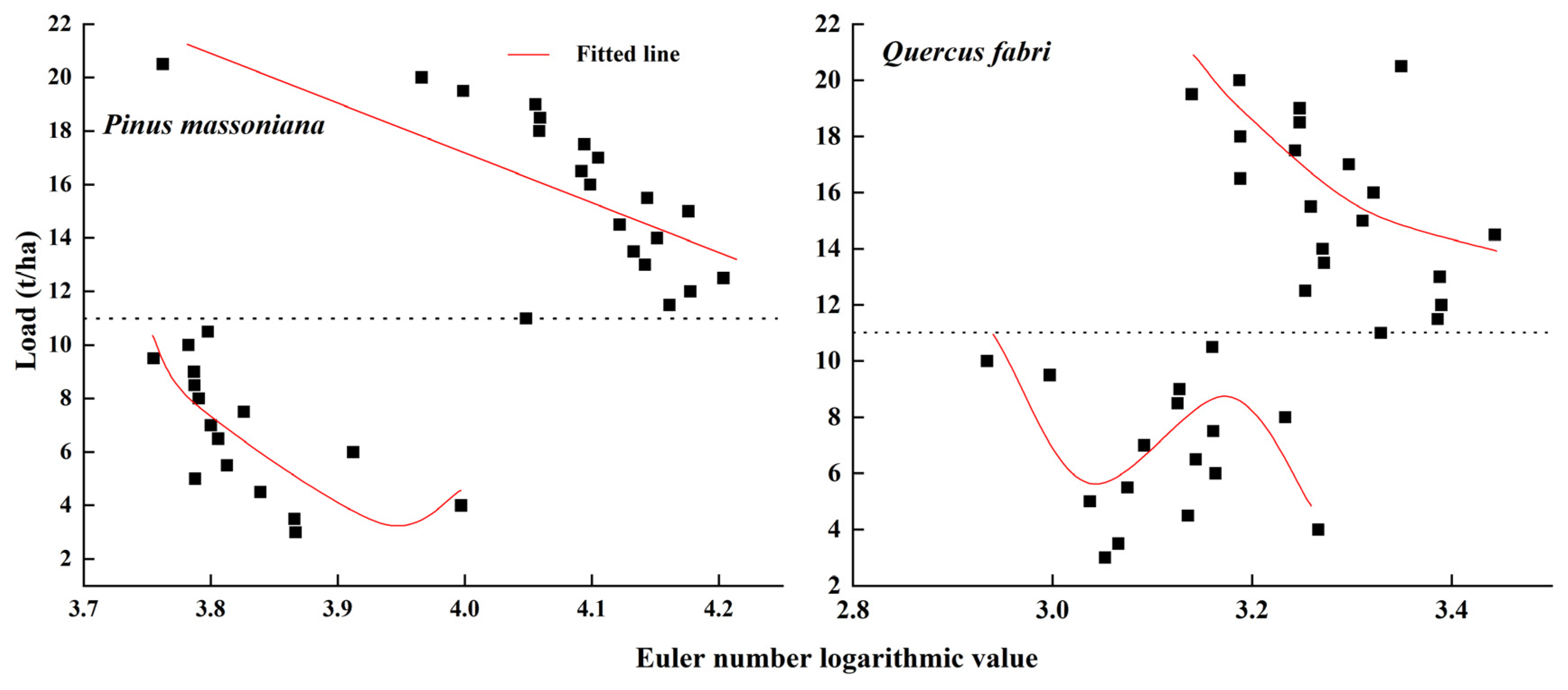


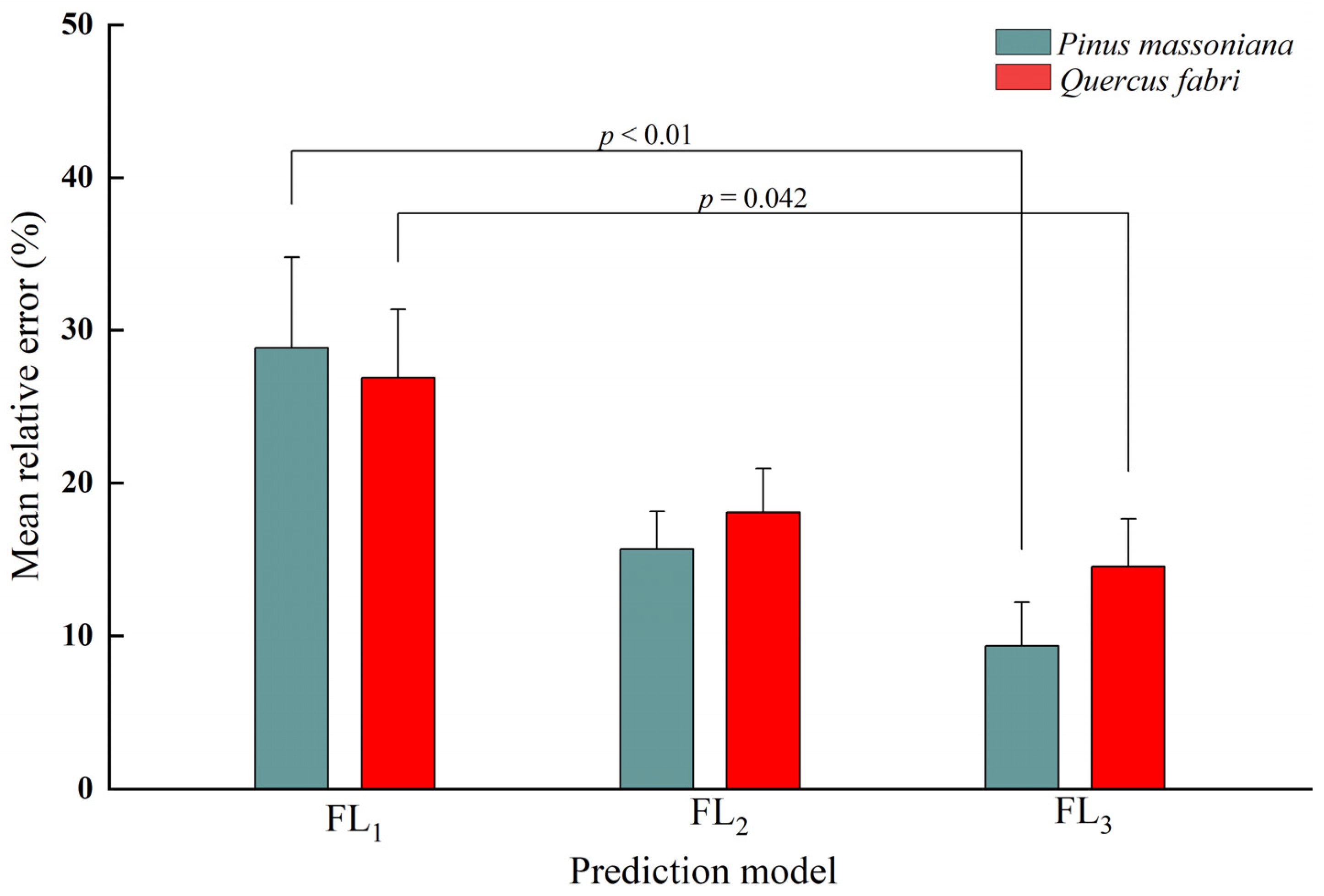
| Forest Type | Standard Plot Number | Mean DBH (cm) | Mean Tree Height (m) | Slope (°) | Aspect | Slope Position | Range of Load (t/ha) | Range of Depth (cm) |
|---|---|---|---|---|---|---|---|---|
| P. massoniana | 1 | 16.3 | 18.2 | 10.6 | South | Down | 3.6–10.8 | 3.1–4.8 |
| 2 | 12.8 | 13.9 | 9.7 | South | Mid | 2.9–6.7 | 2.6–5.4 | |
| 3 | 16.6 | 19.4 | 8.1 | Southwest | Down | 3.5–16.4 | 3.6–7.9 | |
| Q. fabri | 1 | 9.6 | 10.3 | 34.3 | Southwest | Down | 4.3–11.6 | 3.0–5.0 |
| 2 | 8.7 | 10.1 | 19.7 | West | Mid | 3.7–9.7 | 2.3–4.8 | |
| 3 | 11.2 | 11.7 | 22.3 | Southwest | Mid | 5.1–16.5 | 2.8–6.6 |
| Fuel Type | Model | R2 | MAE (t/ha) | MRE (%) | RMSE (t/ha) |
|---|---|---|---|---|---|
| P. massoniana | FL1 = −3.44 − 0.001867E0.05 + 0.002474E0.10 + 0.002736E0.70 − 0.002153E0.90 + 0.003684E0.95 | 0.637 | 2.39 | 28.85 | 2.89 |
| Q. fabri | FL1 = −0.79 − 0.00507E0.25 − 0.00806E0.3 + 0.00309E0.4 + 0.00180E0.75 + 0.00237E0.80 − 0.005E0.85 + 0.006677E0.9 − 0.00177E0.95 | 0.654 | 2.22 | 26.89 | 2.68 |
| Fuel Type | Load (t/ha) | Model | R2 | MAE (t/ha) | MRE (%) | RMSE (t/ha) |
|---|---|---|---|---|---|---|
| P. massoniana | 3.0–10.5 | FL2 = 3154.12 − 1601.11 × log(E0.7) + 203.43 × log(E0.7)^2 | 0.504 | 1.48 | 14.65 | 1.82 |
| 11.0–20.5 | FL2 = 104.28 − 21.66 × log(E0.7) | 0.485 | ||||
| Q. fabri | 3.0–10.5 | FL2 = 49,747.73 − 48,005.91 × log(E0.05) + 15,434.91 × log(E0.05)^2 − 1653.27 × log(E0.05)^3 | 0.251 | 1.69 | 18.09 | 2.10 |
| 11–20.5 | FL2 = 692.22 − 390.01 × log(E0.05) + 56.01 × log(E0.05)^2 | 0.274 |
Disclaimer/Publisher’s Note: The statements, opinions and data contained in all publications are solely those of the individual author(s) and contributor(s) and not of MDPI and/or the editor(s). MDPI and/or the editor(s) disclaim responsibility for any injury to people or property resulting from any ideas, methods, instructions or products referred to in the content. |
© 2024 by the authors. Licensee MDPI, Basel, Switzerland. This article is an open access article distributed under the terms and conditions of the Creative Commons Attribution (CC BY) license (https://creativecommons.org/licenses/by/4.0/).
Share and Cite
Zhang, Y.; Tian, L. Predicting Fine Dead Fuel Load of Forest Floors Based on Image Euler Numbers. Forests 2024, 15, 726. https://doi.org/10.3390/f15040726
Zhang Y, Tian L. Predicting Fine Dead Fuel Load of Forest Floors Based on Image Euler Numbers. Forests. 2024; 15(4):726. https://doi.org/10.3390/f15040726
Chicago/Turabian StyleZhang, Yunlin, and Lingling Tian. 2024. "Predicting Fine Dead Fuel Load of Forest Floors Based on Image Euler Numbers" Forests 15, no. 4: 726. https://doi.org/10.3390/f15040726





